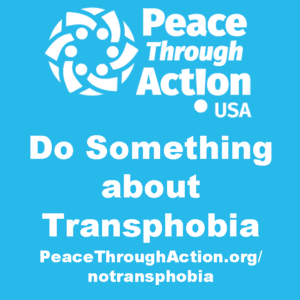
What is transphobia?
Transphobia is the fear, hatred, disbelief, or mistrust of people who are transgender, perceived as transgender, or whose gender expression doesn’t conform to traditional gender roles. Transphobia is a result of cissexism, which is a system of oppression like racism, ageism, and sexism.[1]
[1] Planned Parenthood, (n.d.). What’s Transphobia? | Facts About Transphobic Discrimination. Retrieved September 28, 2017, from https://www.plannedparenthood.org/learn/sexual-orientation-gender/trans-and-gender-nonconforming-identities/whats-transphobia.
How widespread is transphobia in the United States?
Transphobia, as we know it today in the U.S., derives from the cissexist systems and institutionalized norms put into place by the colonial notion of a binary gender structure: (cis)man and (cis)woman.[2] Therefore, people with gender identities that do not fit within this socially constructed idea of gender can be subject to transphobia. Some examples of both interpersonal and institutional transphobia include:
- Children and adolescents in school (K–12) experience some form of mistreatment, including verbal harassment (54%), physical assault (24%), and sexual assault (13%) because they are openly transgender or perceived as transgender.
- In 2015, nearly one-quarter (23%) of transgender or GNC (gender non-conforming) people reported some form of housing discrimination.
- In 2015, 30% of transgender or GNC people who had a job reported being fired, denied a promotion, or experiencing some other form of mistreatment in the workplace due to their gender identity or expression.
- Nearly half (47%) of transgender or GNC people are sexually assaulted at some point in their lifetime.
- Overall, transgender and GNC people are about twice as likely as the general population (14%) to live in poverty. Transgender and GNC people of color are about three times as likely to live in poverty.[3]
[2] Hanna, K. B. (2017). A Call for Healing: Transphobia, Homophobia, and Historical Trauma in Filipina/o/x American Activist Organizations. Hypatia, 32: 696–714. doi: 10.1111/hypa.12342
[3] James, S. E., Herman, J. L., Rankin, S., Keisling, M., Mottet, L., & Anafi, M. (2016). The Report of the 2015 U.S. Transgender Survey. Washington, DC: National Center for Transgender Equality.
What culture changes and public policies are necessary for preventing transphobia?
Many of the cultural shifts should come from school environments so that perceptions may be altered at an early age, such as awareness and education workshops for both teachers and students, as well as inclusive sexual education courses.[4] The same can be applied to the workplace and community spaces. Gender neutral bathrooms also help to create safe spaces. There are many potential policy changes, some of which include State-level non-discrimination protections, inclusive health insurance, and inclusive hate crime law.[5]
[4] Kitchen, J., & Bellini, C. (2012). Addressing Lesbian, Gay, Bisexual, Transgender, and Queer (LGBTQ) Issues in Teacher Education: Teacher Candidates’ Perceptions. Alberta Journal of Educational Research, 58(3), 444-460. Retrieved from http://ajer.journalhosting.ucalgary.ca/index.php/ajer/article/view/1058
[5] Veldorale-Griffin, A., & Darling, C. A. (2016). Adaptation to parental gender transition: Stress and resilience among transgender parents. Archives of sexual behavior, 45(3), 607-617.
What practical solutions are effective for preventing transphobia?
Peaceful practical solutions to prevent transphobia include community dialogue spaces, bias reduction trainings, awareness-building trainings, and restorative justice processes. Learn more about these practical peaceful solutions in our Choose Peaceful Practices series.
What can I do to prevent or stop transphobia?
- Educate yourself – Do your homework on what being transgender means and understand that you do not always know if a person identifies as transgender or GNC by looking at them.
- Know the appropriate questions to ask –If you don’t know a person’s pronouns, ask politely and respectfully, without making a big deal about it. If you accidentally use the wrong pronouns, apologize and move on. It is inappropriate and disrespectful to ask about a person’s transition process, name given at birth, and sexual activity. Avoid comments related to whether their presentation conforms to traditional gender norms.
- Speak up, not for – Politely correct someone if they misgender a person and challenge transphobic jokes or remarks. If you witness an act of transphobia and it is safe to intervene, do so by getting the trans person to a safe space away from the harasser. When speaking up, be sure to acknowledge that you might not fully understand what it means to identify as trans.
- Take action – Volunteer with organizations that work for the rights of the transgender community. Call your elected officials. Work with schools, prisons, businesses, and public authorities to incorporate inclusive measures and policies. [6]
[6] Supporting the Transgender People in Your Life: A Guide to Being a Good Ally. (2016, July 10). Retrieved October 09, 2017, from http://www.transequality.org/issues/resources/supporting-the-transgender-people-in-your-life-a-guide-to-being-a-good-ally
What can I find statistics about transphobia?
For data and statistics about transphobia, go to the National Center for Transgender Equality’s National Transgender Discrimination Survey: http://www.transequality.org/issues/national-transgender-discrimination-survey
Where else might I go to learn about transphobia?
Some organizations with expertise in fighting transphobia and advocating for equality are:
- The National Center for Transgender Equality educates and advocates for social justice.
- The Transgender Law Center changes law, policy, and attitudes to fight discrimination.
- The Trevor Project provides crisis intervention and suicide prevention services.
- Stop Bullying provides tips on how to create a safe environment for LGBTQI+ Youth
- Centers for Disease Control and Prevention (CDC) provides tips on other ways to support LGBTQ youth
Information Sheet-Do Something-Transphobia (PDF)
Have a suggested improvement to this information sheet? Send it to inbox@peacethroughaction.org
Do Something Right Away to Increase Peace
Subscribe to our YouTube channel
Give money to support Peace Through Action’s mission delivery activities
Choose opportunities to take part in our #PeaceBeginsWithWe campaign
